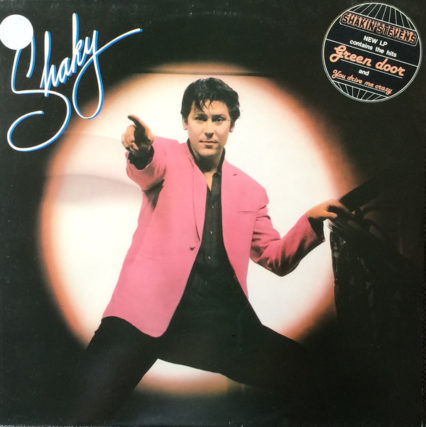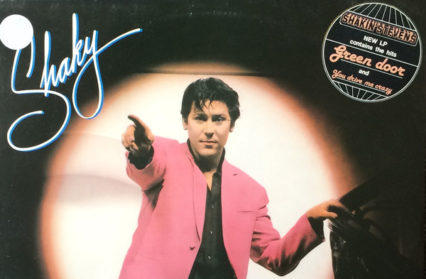A new series for the 2019 Wales Arts Review is asking what are the greatest albums ever produced by Welsh musical artists? A wide selection of writers will be examining their favourites, and here Goldie Lookin’ Chain’s Gray Taylor looks at the 1981 number one album from the biggest selling British singles artist of the 1980s. That’s right, it’s Shaky by Shakin’ Stevens.

I do try my best not to mention David Bowie in every article I write; however, it does seem unlikely that the editor of Wales Arts Review will allow me to write about any Bowie albums in this series on classic Welsh albums (I mean, Dai Jones!), so I’d like to start with a quote from one of his lesser-known singles, “Buddha Of Suburbia”, in which he sings, “Elvis is English and climbs a hill”. Close, David; but that hill may well be in Wales. Yes, that’s right, there is very persuasive evidence that Elvis’ ancestors may well have spawned from Wales.
Of course, in 1977 Elvis was actually Welsh. Sort of. When a 29-year-old Michael Barratt took to the stage in Elvis!, a brand new West End musical based on the life of the titular rock ‘n’ roller. By this point, Michael was already known as “Shakin’ Stevens”, albeit by some retro greasers and twelve German TV fans, for at this point the UK’s biggest-selling singles artist of the 1980s had notched up not one hit in the previous seven years recording with his band The Sunsets.
It wasn’t until a total eclipse of The Sunsets and a new manager, Freya Miller, happened in 1979 that the seeds of the hit machine were sown. In 1980, Shaky released two albums; one of them twice (Marie Marie, his second of 1980). After the title single and follow up, “Shooting Gallery”, failed to break the top ten, the album was re-titled and rejigged ever so subtly when a song about a broken down residence stormed to number one, not just in the UK but also in Australia, Ireland, and Sweden. That’s right, in 1980 you couldn’t get away from “This Ole House” and the new look Shaky. Originally, the album and promotion had tried to show Shaky as a tough, jumper-wearing, a rocker who was not to be messed with, which led to an embarrassing moment when he treated Richard Madeley like his own personal soft play area on live TV. This image was quickly aborted presumably when Shaky and management recalled his success as Elvis. “The Welsh Elvis, hey that could be a thing!”
So, rather than look towards the parent-baiting, pelvis-shifting icon of the ‘50s, they sensibly took inspiration from the cleaner cut, smoother pop star of the early ‘60s, who could, of course, still rock with the best of them. Elvis could appeal to parents, teenage girls and boys, and very young children alike. In 1981, I fall into the latter category being an already music-obsessed 3 years old with doting parents that would intrigue me with their early Rock ‘n’ roll, Elvis, and Beatles records as well as bringing home a good selection of modern chart music presumably that they had witnessed me enjoy on my second favourite programme Top Of The Pops. The first record I remember my lovely mum bringing me home is the very record I am now looking at as I write this. Tatty, unglued edges, ripped, a-bit-scratched vinyl of mine… what an adventure we have been on together since that day.
At this point, you, dear reader, may well be questioning, “Is he really waxing lyrical about Shakin’ Stevens?” I get it; there really hasn’t been a traditional rock ‘n’ roll revival of such impact since, but in 1981 it was par for the course. The 70s had a big boom in revivalist bands like The Darts, Showaddywaddy, and Shaky and the Sunsets. The 80s didn’t just have Shaky but also rockabilly bands like Stray Cats and The Jets. In 1981, this is somewhat of a zeitgeist; with that iconic pink jacket adorning the cover, Shaky is channelling family-friendly Elvis before you’ve heard a note. Pointing at us, you guys can all come along for the ride, which is what all great pop music makes you feel. So, it was not that difficult for Shaky to catch the imagination of the public in this climate of… not nostalgia… but a climate where rock ‘n’ roll had actually been briefly revived.
Now, you may be thinking that I’m seeing this through the rose-tinted glasses of my childhood, but seriously, Shaky is a great pop album, in the best possible way: it’s fun. A great mixture of cover versions and original material, the album is far more diverse than merely a rock ‘n’ roll tribute album. As always, the Shakemeister covers tunes from largely a crooner template or family-friendly 50s pop, rocking them up and making them the new sound of rock ‘n’ roll. So, Nat King Cole’s classic single, “Mona Lisa”, becomes a storming country-rock opener to the album, shaving off The King’s genius approach to smooth vocal phrasing. Later on the album, he takes 30’s standard “I’m Gonna Sit Right Down And Write Myself A Letter”, popularised by Fats Waller, and turns it into a bluesy, country jam, (the only other version I’m really familiar with is the Mrs Mills version my nan used to play). Most famously, Shaky takes Jim Lowe’s easy listening pop hit “Green Door” and, guess what turns it into a massive number one hit for 1981. That single spent four weeks at the top spot; the cool cat swing, pumping piano and slashing guitar perfectly soundtracking 1981’s summer – and I’m telling you hundreds of kids learnt to click their fingers because of this track.
These covers sit effortlessly next to new compositions and Shaky originals. Ronnie Harwood’s “You Drive Me Crazy”, another worldwide chart smasher, sounds as exciting now as it did then and I can’t help but smile at Shaky’s ubiquitous pronouncing of his “r”s as a “w’’, henceforth we get “You dwive me cway-way-zy”, and later we get, “Cwied just little bit.” Classic pop. Along with “It’s Raining”, all three of the albums’ hit singles reside on side one.
That’s not to say that Shaky is a three trick pony; in fact, side two has four of the five original Shaky-penned songs. These originals are the perfect example of why he was so popular – a classy combination of R ‘n’ B, straight-ahead blues, traditional rock, doo-wop pop hooks, and a tearing rock voice (as on “I’m Knockin’”). Plus, add to that Shaky’s natural gift for writing a song that can succeed cross-generationally – don’t forget that this is the guy who took Rosemary Clooney’s “This Ole House”, rocked it up, and went straight to number one. I mean, the content of the lyrics isn’t going to lay waste to governments, sure, but, like on “Baby, You’re A Child”, this is the essence of the classic pop lyric, relationships between lovers, friends, and family. There’s a bluesy, sexiness to “Don’t Turn Your Back”, that really had only been attributed to Elvis before; and let us not forget the other King had only been dead four years, he was missed by a great deal of people.
The playing on this Shakin’ Stevens album is some of the most effortless-sounding, precise rock ‘n’ roll you’ll ever hear. This period of Shaky’s music was dominated by the unmistakable funky, country twang of Mickey Gee’s lead guitar and married beautifully with Geraint Watkins’ honky-tonk piano.
The Shaky album made Shakin’ Stevens a huge, worldwide chart concern. The genius melding of the traditional, accessible, and undeniably rocking, along with capitalising on a good looking fella in much the same way the powers that be had with Elvis. OK, so no one is pure sex as much as Elvis in 1956, but if you squint a little, Shaky is definitely a close second or third in 1981 – there was a lot of squinting going on, hence huge hits, more Top of the Pops performances than anyone else, and a feeling of genuine goodwill that still exists today for Shaky as he embarks on a Greatest Hits tour.
I always dreamed of being that little kid in the “This Ole House” video, and years later when me and my GLC bandmates appeared in an all Welsh video for Comic Relief, I was edited in after Shaky, so my dream kind of came true. My other dream was that he would come to my 9th birthday party. I wrote an invitation for him and took it, along with some Shaky Fimo badges me and my friends had made, to see him in concert in Newport with our parents. With trepidation, we approached a huge bouncer at the front of the stage and asked him if he would pass on our gifts and my invitation to Shaky. He said he would. Had I an ounce of the cynicism about human nature that comes with age, then I probably wouldn’t have bothered. Anyway, a few weeks later a letter came through the door addressed to me. It contained a signed photo and letter explaining that he was on tour and couldn’t make my birthday party at the cinema to watch Back To The Future. It blew me away. I still have the letter and picture.
After listening to this album I wanted to get up on stage and eventually I did. So, if you ever happen to read this Shaky, thanks for this album, I still listen to it, thanks for inspiring me, and thanks for sending me a letter. I’m a Shaky fan and I don’t care who knows it.
Shaky by Shakin’ Stevens is available through here.
Gray Taylor is a regular contributor to Wales Arts Review.
For other articles included in this collection, go here: The Greatest Welsh Album












